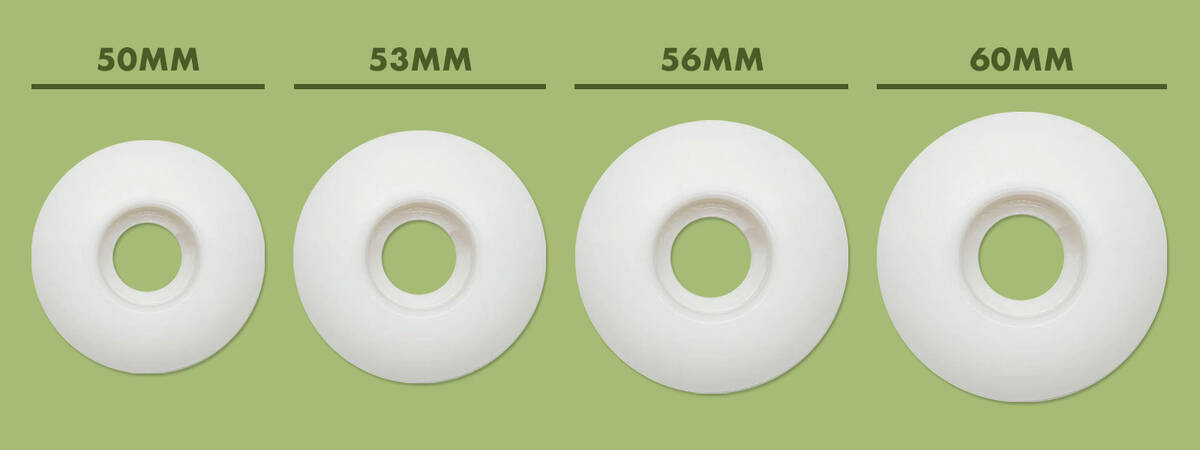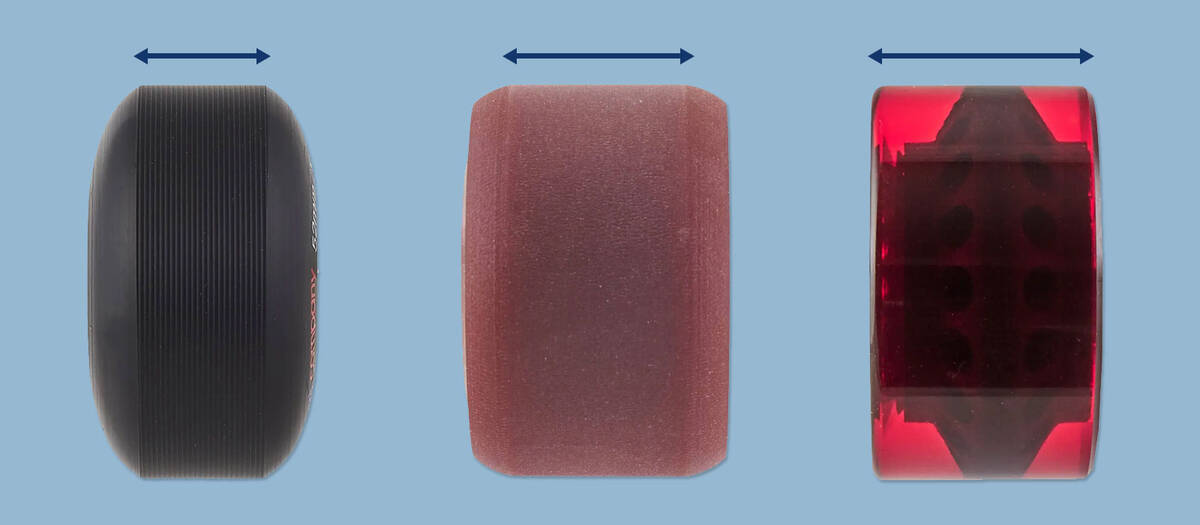Guide to Buying Skateboard Wheels
Skateboard wheels are important for your performance – whether you’re a beginner or a pro. They have a significant influence on your skateboarding experience, and switching to a different type of wheel can completely transform your skateboard setup. For this reason, it is a good idea to reflect on the options available when choosing skateboard wheels.
This guide aims to provide you with insights when searching for new skateboard wheels. Please check the contents below and jump to the section you are interested in, so we can help you find the best wheels for your skateboard.
Overview
Overview
How to Choose Skateboard Wheels

When selecting skateboard wheels for your setup, there are two main factors to consider: size and hardness. It's crucial to choose the right size skateboard wheels to avoid issues such as wheel bites.
In addition to size and hardness, it's important to consider variables such as shape, which determines the contact patch (the part of the wheel in contact with the ground), and wheel material, which influences properties like grip, rebound, and weight.
Throughout your considerations, your personal preferences and riding style will guide you. Ultimately, the best skateboard wheels are those that suit your style and preferences, providing the most fun on the board, whether you're a beginner or a pro!
Below, you'll find more specific and detailed advice on choosing the perfect skateboard wheels for your needs.
Skateboard Wheel Sizes

Skateboard wheel sizes are measured by diameter, and the size of your wheels significantly influences characteristics such as speed, acceleration, and maneuverability.
Agile and technical skaters typically prefer smaller wheels, while larger wheels are great for cruising or vert skating. These are the general differences between large and small skateboard wheels:
Smaller wheels:
- Agile, maneuverable, and excellent for tricks. Although they may not achieve the same speeds as larger wheels, they are more responsive.
- Less forgiving and more prone to sudden stops if a small pebble gets in their way.
- Mellower pop-angle which means that less effort is required for flip tricks and popping ollies.
- Low trucks are compatible with smaller wheels, enabling you to position the center of gravity as close to the ground as possible.
Bigger wheels:
- Higher speeds with slower acceleration and less agility.
- More forgiving when you hit small pebbles or other irregularities in the surface you are skating on.
- Steeper pop-angle which can give you more leverage to pop big tricks, but also require more effort to pop. To reiterate: bigger wheels are less agile.
- Higher trucks or riser pads are possibly needed to avoid wheel bites.
The most common size range for skateboard wheels is about 52-56 mm. Unless you primarily engage in heavy vert shredding or cruising, you are likely to find skateboard wheels that meet your needs within this range.
Below is a skateboard wheel size chart, offering a quick overview of wheel diameters and the skateboard disciplines commonly associated with each size.
| Size | Size in mm | Recommended for |
| Medium sized wheels | 50-53 mm | Street, park |
| Medium sized wheels | 53-56 mm | Street, park, bowl, mini ramp |
| Large skateboard wheels | 56-60 mm | Cruising, vert |
You can filter our selection of skateboard wheels by wheel diameter to find the wheels that fit your needs:
Skateboard Wheel Hardness – The Durometer Scale
Skateboard wheel hardness is measured using the durometer scale, typically indicated by a number followed by an A. For example, 100A wheels are harder than 99A wheels. In some instances, durometer specifications use a B instead of an A, indicating a subtraction of 20 units from the A-scale. For instance, 83B wheels equate to 103A.
The following principles may help you decide whether to opt for skateboard wheels that are either harder or softer than your current ones:
Harder wheels
- Greater speed and durability
- Less grip and shock absorption
- Shaky and noisy on rough surfaces
- Responsive and fast on smooth surfaces
- Great for tricks in streets or skateparks
Softer wheels
- More grip at the expense of speed and longevity
- Absorb vibrations and roughness of uneven surfaces
- Skateboard filming wheels should ideally be soft to minimize shaking and noise
- Great for cruising everywhere
| Hardness | Durometer | Recommended usage |
| Very soft wheels | 78A - 90A | Cruising, filming, commuting, beginners |
| Medium soft wheels | 90A - 97A | Cruising, rough surfaces, commuting, beginners |
| Medium hard wheels | 97A - 99 | Street skating, mini ramps, skateparks |
| Hard wheels | 99A + | Technical skateboarding |
When you browse our selection, you can filter the results by wheel hardness and other important specifications, ensuring you only see the wheels that are relevant to your needs:
Skateboard Wheel Shape - Contact Patch & Lip Shape

The contact patch is the most important factor to consider when it comes to skateboard wheel shapes. ‘Contact patch’ refers to the part of the wheel that touches the ground when you are skating.
A narrower contact patch results in increased responsiveness, reduced friction, and increased susceptibility to sliding (better for blunt slides!). With slim skateboard wheels, your weight is concentrated on a smaller surface, making vibrations from rough surfaces more noticeable. Additionally, narrow skateboard wheels are lighter, since they have less material on the sidewalls.
On the other hand, a wider contact patch makes for a more grippy and stable wheel that doesn’t slide as easily as a wheel with a narrower contact patch. However, having a wide contact patch makes the wheel less responsive and also results in wheels that weigh more.
Furthermore, a rounded profile, or lip shape, makes it easier to roll over copings and avoid hang-ups when skating transitions.
Wide contact patch:
- Grippier and more stable
- Don’t slide as easy
- Less responsive
- Wider wheels weigh more
Slim contact patch:
- More responsive
- Less friction
- More prone to sliding
- Vibrations from rough surfaces are more pronounced
- Slim skateboard wheels weigh less
What Are Skateboard Wheels Made Of?
Skateboard wheels are made of polyurethane and wheel manufacturers constantly improve and develop new urethane mixtures to produce wheels that perform better. By altering the urethane mixture, they can change the hardness, durability, smoothness, bounce, and sliding capabilities of the wheel.
Skateboard Wheel Bounce (Urethane and Its Properties)
Skateboards wheels were made of metal or ceramics before the urethane skateboard wheels hit the market. The introduction of the first urethane skateboard wheels was a huge advancement for a simple reason. Unlike their predecessors, urethane wheels had an important attribute: bounce. When a urethane wheel hits a hard surface, it momentarily deforms, but quickly rebounds to its original shape, creating the characteristic bounce. Thanks to their ability to bounce, urethane skateboard wheels revolutionized the sport, paving the way for skateboarding as we know it today.
Stringent requirements in production processes determine the quality of skateboard wheels. PU formulas, molding techniques, curing, and baking temperatures are at the heart of skateboard wheel innovation. In your choice of skateboard wheels, you will mainly be looking at their size, hardness, and shape. But since fine-tuning of PU formulas and production techniques have such a big impact on the quality of skateboard wheels, it is always a good idea to go for high quality wheels from trusted brands.
Best Skateboard Wheels For Park
Skateboard wheels for park skating should be small to medium-sized (typically 50-56mm) with a hardness rating (durometer) between 99A to 101A for smooth and responsive performance on smooth surfaces. A rounded shape ensures versatile maneuverability for tricks and transitions, while high-quality polyurethane construction offers durability and excellent grip on ramps and bowls.
Best Skateboard Wheels for Street
Skateboard wheels for street should be small to medium-sized (50-56 mm) with a hardness rating (durometer) of 97A to 101A for optimal responsiveness and control on rough urban terrain. A wider contact patch enhances stability for tricks like slides and grinds, while a conical or rounded shape ensures quick acceleration and maneuverability. High-quality polyurethane is essential for durability and reliable grip on concrete and asphalt surfaces.
The above advice applies to street skateboarding. If you are just cruising the streets, you will probably enjoy larger wheels. They offer a smoother ride on rougher surfaces. You should also go for wheels that are softer than 97A (Go for wheels in the range 78A - 85A if you only cruise!).
